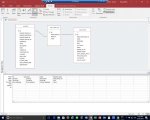I have the following 3 tables:
Project Table = contains a unique Project_ID and Project_Name
FieldNames Table = contains a unique Field_ID, Field_Name (EG: CustName, Cust St, ContractAmt, etc) and Field TYPE there are about 65 fields for each project. All the data is stored as text (even dates and numbers) but I can convert those once I get them into a usable table.
FieldData Table = containng the following fields:
BindID_P - Linked to the Project_ID
BindID_F – Linked to the Field_ID
Value – contains the data for the field
I know this is NOT a normalized database but it is what I have pulled in from another SQL database via ODBC.
I need to figure out a way to create a table or query that puts all the data from the FieldData table into a single record for each project like the following:
_________Cust Name__________ Cust St__________ Contract Amt
Project1
Project2
Project3
Etc.
Any help would be greatly appreciated and thank you in advance.
Project Table = contains a unique Project_ID and Project_Name
FieldNames Table = contains a unique Field_ID, Field_Name (EG: CustName, Cust St, ContractAmt, etc) and Field TYPE there are about 65 fields for each project. All the data is stored as text (even dates and numbers) but I can convert those once I get them into a usable table.
FieldData Table = containng the following fields:
BindID_P - Linked to the Project_ID
BindID_F – Linked to the Field_ID
Value – contains the data for the field
I know this is NOT a normalized database but it is what I have pulled in from another SQL database via ODBC.
I need to figure out a way to create a table or query that puts all the data from the FieldData table into a single record for each project like the following:
_________Cust Name__________ Cust St__________ Contract Amt
Project1
Project2
Project3
Etc.
Any help would be greatly appreciated and thank you in advance.
Last edited:

